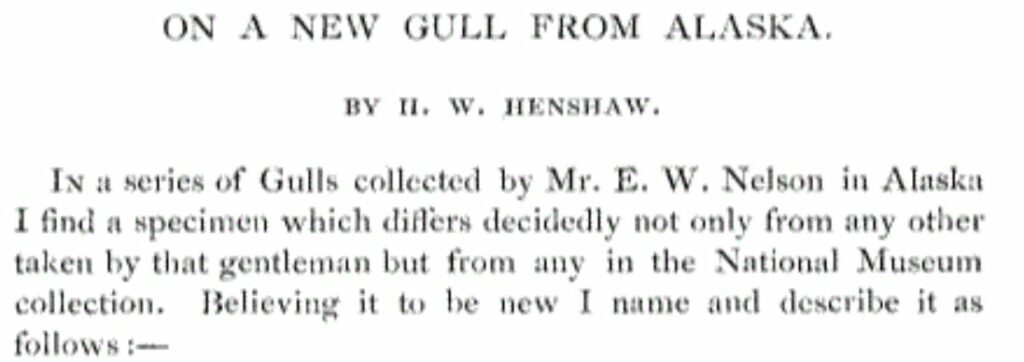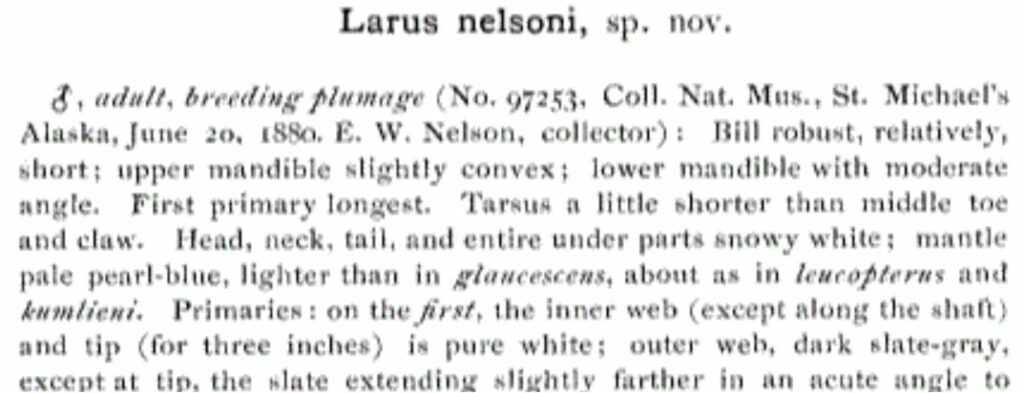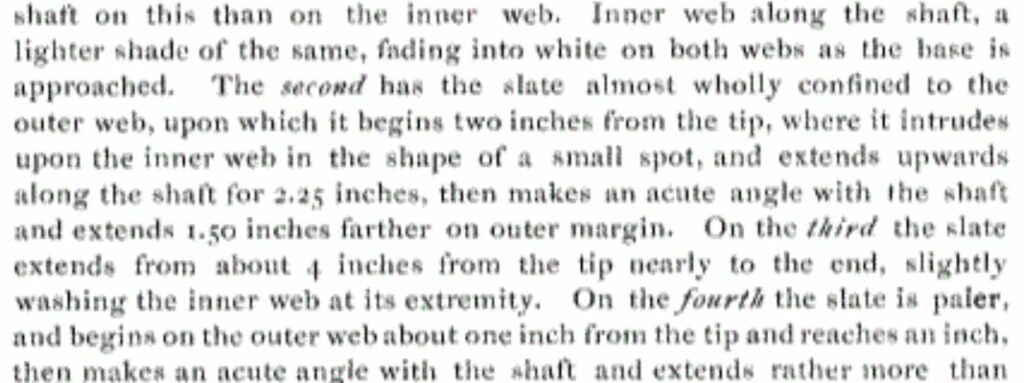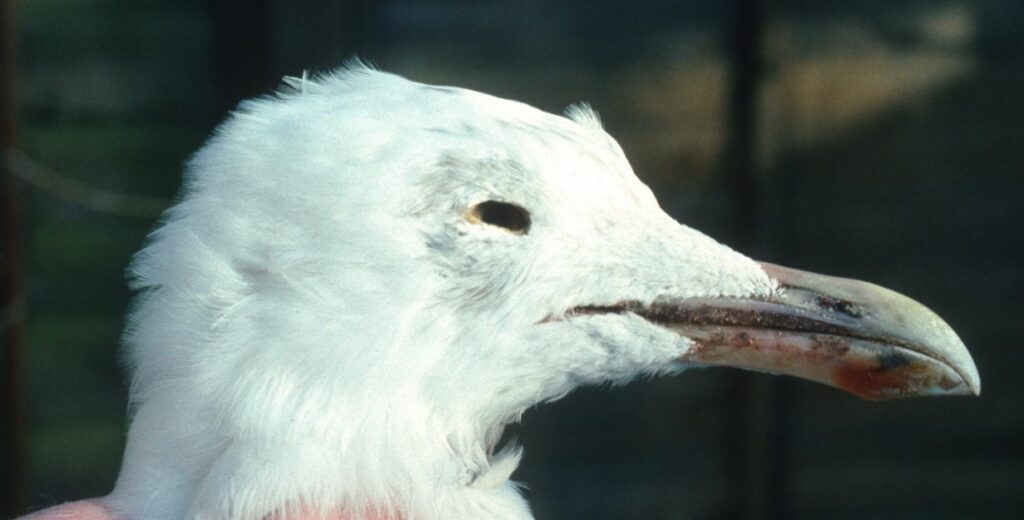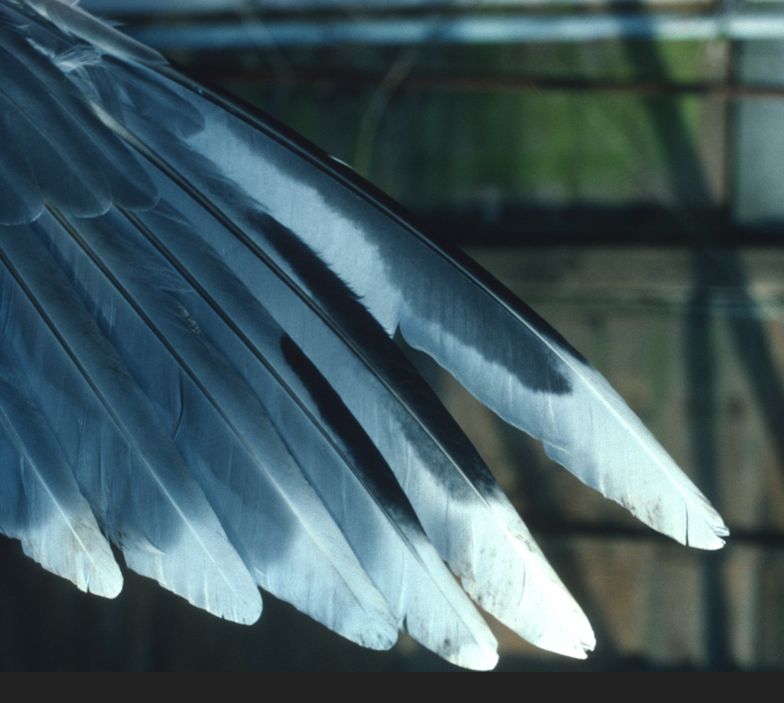Nelson’s gull
Larus nelsoni. NELSON’S GULL. In 1884, Mr. H. W. Henshaw ventured to
describe this species on the strength of a single breeding male from
Alaska (U.S. Nat. Mus. No. 97253, •St. Michaels, Alaska, June 20, 1880).
Since then a specimen from Bering Straits has turned up in the
42 DWIGHT, The White-winged Gulls. [‘Auk I. Jan. British Museum, another
male from St. Michaels in the Acad. Nat. Sci. of Philadelphia (No.
37692, St. Michaels, Alaska, • Sept. 5, 1897) and recently a fourth
(Mus. Carnegie Inst. No. 7729, Q, San Geronimo I., Lower California,
March 18, 1897) which is apparently a nearly ad aauk female has been
taken at a surprisingly southern locality. I have examined all of these
four birds and find that the type, the specimen in the British Museum,
and the bird in the Philadelphia Academy are very similar, and the
pattern of the primaries corresponds very nearly to the type specimen of
kumlieni, the outer webs being slaty or brownish bu[ the terminal
bands’much less distinct. The Carnegie specimen, on the other hand, is
nearly the counterpart of the U.S. Nat. Mus. specimen of kumlieni (No.
161845) described above; there is no banding, but merely dusky outer
webs of the primaries. Doubtless in time other specimens will be
obtained, but judging from the few extant, nelsoni seeras to have as
good a claim for specific distinctness as does kumlieni, of which it
appears to be a large edition. It is a species abo.ut the size of
glaucus and as much larger than kumlieni, 16 %, as glaucus is larger
than leucopterus. The bill, however, seems .,to be only about 24 %
larger, but with tarsi and toes relatively very large. The young bird
has never been described, but inasmuch as kumlieni in juvenal plumage is
scarcely to be distinguished from glaucescens, there is every reason for
expecting the correspon•ding plumage .of nelsoni to be practically the
same. The birds, though, ought to be larger than glaucescens and I have
no doubt that very large specimens now labelled ‘glaucescens’ invarious
collections will eventually prove to be nelsoni. Such a bird has been
recorded in the British Museum Catalogue, but somehow I overlooked it
when examining the collection. In the American Museum, however, I find
two specimens (Nos. 26234 and 61536) so much larger than glaucescens
usually is that I believe them to be nelsoni. The tarsi and feet are
unusually large and massive and the bills very heavy. The bird in the
Philadelphia Academy is completing an adult postnuptial moult, but the
other specimens throw very little light on the subject of moult in this
species. While I may not have been entirely successful inuntangling the
confusing multitude of so-called immature plumages in these spe-
Vol. XXlII’] DWIGHT, The White-winged Gulls. 43 1906 J cies, I have at
least shown the way to complete success. To call a plumage merely
“immature” is to confess we do not know much about it. Each of the
species under consideration has no less than five plumages that may be
called “immature,” the juvenal, the first winter, the first nuptial, the
second winter and the second nuptial, and in a few exceptional cases we
may add the third winter and the third nuptial, making seven. Even the
large amount of material I have examined does not make every one of
these plumages perfectly clear, but it is only by the comparison of
comparable plumages that we shall ever arrive at the desired goal. There
is a large portion of Arctic America still unexplored, and with other
material it may some day be necessary to revise in part my present
conclusions. My work has been prosecuted at intervals during several
years but I trust it has lost nothing by being so long delayed. Iain
indebted to many institutions and individuals for courtesies and for the
loan of specimens, particularly to Dr. Sharpe and Mr. Grant of the
British Museum; to Mr. Harteft of the Rothschild Museum at Tring; to Dr.
Reichenow of the Berlin museum; to Mr. Ridgway and Dr. Richmond of the
U. S. Nat. Museum; Mr. Nelson of the Biological Survey; to Dr. Allen and
Mr. Chapman of the American Museum of Natural History; to Mr. Stone of
the Philadelphia Academy of Natural Sciences; and to the following
private collectors, viz. Mr. O. Bangs, Mr. C. F. Batchelder, Dr. L. B.
Bishop, Mr. Wm. Brewster, Dr. Wm. C. Braislin, Mr. R. W. Peavey, Mr. L.
H. Porter, and Mr. Everett.


